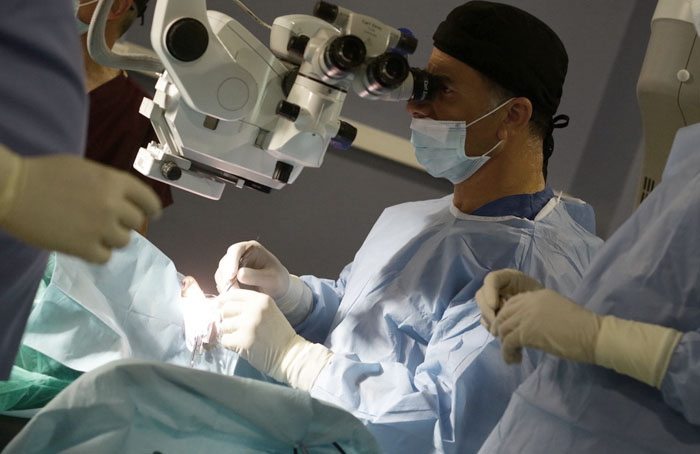Tumors of the Eye
Eye tumors are abnormal growths that can develop in various ocular structures, including the eyelids, conjunctiva, intraocular tissues, and the orbit. These tumors can be benign or malignant, with the latter posing a significant risk of vision loss and metastasis. Early diagnosis and appropriate management are essential for preserving vision and preventing complications. This article provides an overview of the types of eye tumors, their diagnosis, and comprehensive management strategies.

1. Eyelid Tumors
- Benign tumors: Papilloma, seborrheic keratosis, nevus.
- Malignant tumors: Basal cell carcinoma, squamous cell carcinoma, sebaceous gland carcinoma.
2. Conjunctival Tumors
- Benign tumors: Nevus, epibulbar dermoid.
- Malignant tumors: Conjunctival melanoma, squamous cell carcinoma.
3. Intraocular Tumors
- Benign tumors: Choroidal hemangioma, retinal astrocytoma.
- Malignant tumors: Retinoblastoma, uveal melanoma.
4. Orbital and Optic Nerve Tumors
- Benign tumors: Cavernous hemangioma, pleomorphic adenoma.
- Malignant tumors: Rhabdomyosarcoma, optic nerve glioma, metastatic tumors.
- Clinical Examination: Slit-lamp biomicroscopy, fundoscopic examination.
- Imaging Techniques: Ultrasound, CT, MRI, fluorescein angiography.
- Biopsy and Histopathology: Essential for definitive diagnosis in suspicious lesions.
- Genetic Testing: Useful in hereditary conditions like retinoblastoma.
1. Eyelid Tumors
- Benign tumors: Simple excision, cryotherapy, or laser ablation if symptomatic.
- Malignant tumors:
- Surgical excision with wide margins to ensure complete removal.
- Mohs micrographic surgery for basal and squamous cell carcinoma to minimize recurrence risk while preserving healthy tissue.
- Reconstructive surgery may be necessary for restoring eyelid function and aesthetics post-tumor removal.
- Radiotherapy can be an adjunct treatment for cases where surgical excision is incomplete or recurrence risk is high.
- Systemic chemotherapy or immunotherapy for aggressive cases, particularly sebaceous gland carcinoma, which can metastasize.
2. Conjunctival Tumors
- Benign tumors: Close observation with periodic eye exams; surgical excision when lesions cause irritation or vision obstruction.
- Malignant tumors:
- Wide surgical excision with cryotherapy to destroy any residual malignant cells and prevent recurrence.
- Topical chemotherapy (mitomycin C, 5-fluorouracil, interferon-alpha) used as adjunctive therapy to treat carcinoma in situ or as a primary treatment for non-invasive lesions.
- Radiotherapy or brachytherapy for more invasive or recurrent tumors, aiming to preserve the eye while controlling the tumor growth.
- Systemic chemotherapy or targeted therapy in advanced conjunctival melanoma to address metastatic spread.
3. Intraocular Tumors
- Benign tumors: Typically monitored through periodic imaging and clinical evaluation; intervention only if growth affects vision or causes complications.
- Malignant tumors:
- Retinoblastoma:
- Systemic chemotherapy (vincristine, carboplatin, etoposide) used in cases of bilateral retinoblastoma or large tumors requiring volume reduction before local treatment.
- Intra-arterial chemotherapy (melphalan) delivered directly into the ophthalmic artery, minimizing systemic toxicity while effectively targeting tumor cells.
- Laser photocoagulation or cryotherapy used for small, localized tumors to destroy tumor cells with minimal side effects.
- Enucleation (complete removal of the eye) is considered in advanced or refractory cases where vision cannot be preserved.
- Proton beam radiotherapy can be used for cases requiring radiation while minimizing collateral damage to surrounding tissues.
- Uveal melanoma:
- Plaque brachytherapy (radioactive plaques placed near the tumor) is the most commonly used eye-sparing treatment for small to medium-sized melanomas.
- External beam radiation therapy employed in larger tumors or cases where plaque brachytherapy is not feasible.
- Enucleation performed when tumors are large, vision is lost, or there is extraocular spread.
- Systemic targeted therapy (BRAF/MEK inhibitors) used in metastatic melanoma cases to slow progression.
- Immunotherapy (checkpoint inhibitors like pembrolizumab) for late-stage melanoma cases with systemic involvement.
- Retinoblastoma:
4. Orbital and Optic Nerve Tumors
- Benign tumors: Observation with regular imaging is recommended for slow-growing lesions; surgical excision performed in symptomatic cases or when growth is suspected.
- Malignant tumors:
- Rhabdomyosarcoma:
- Multimodal therapy, including systemic chemotherapy (vincristine, dactinomycin, cyclophosphamide), is the primary treatment to shrink the tumor before surgery.
- Radiotherapy is frequently combined with chemotherapy to ensure complete tumor eradication.
- Surgical resection performed selectively in cases where complete removal does not compromise vital ocular structures.
- Optic nerve glioma:
- Observation is recommended for small, asymptomatic tumors, especially in pediatric patients with neurofibromatosis type 1.
- Chemotherapy (carboplatin, vincristine) is the primary treatment for progressive tumors causing vision loss.
- Radiotherapy is reserved for older children and adults where chemotherapy fails to control tumor progression.
- Metastatic tumors:
- Systemic chemotherapy and radiation therapy are the mainstay of treatment to manage the primary malignancy and limit further ocular spread.
- Palliative surgical debulking may be considered to alleviate symptoms such as proptosis and pain.
- Orbital exenteration (removal of the eye and surrounding tissues) is a last-resort procedure for extensive tumors that are non-responsive to other treatments.
- Rhabdomyosarcoma:
Eye tumors require a multidisciplinary approach to diagnosis and management. Advances in chemotherapy, radiotherapy, and surgical techniques have significantly improved survival rates and visual outcomes. Early intervention and tailored treatment strategies based on tumor type and location play a crucial role in preserving vision and preventing metastasis. Ongoing patient monitoring and follow-up are essential to detect recurrence and manage potential complications. By employing these comprehensive management approaches, ophthalmologists can enhance both the prognosis and quality of life for patients with ocular tumors